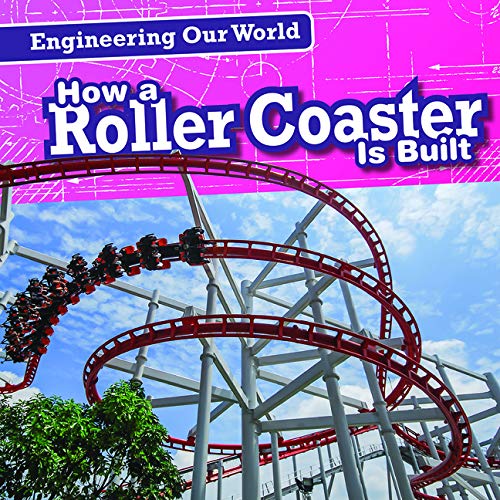-
Singing and rhyming
Lilla Belle Pitts
Hardcover (Ginn, Jan. 1, 1961)264 pages - approx. 9 3/4" by 7 3/4"
-
Singing on our way,
Lilla Belle Pitts
Hardcover (Ginn, March 15, 1951)None
-
Singing and rhyming,
Lilla Belle Pitts
Hardcover (Ginn, Jan. 1, 1959)Boards. Very Good. 4to - over 9¾" - 12" tall. No edition stated, 1st?.Bound in Yellow pictorial cardboard with cloth taped spine. Covers show some creasing & dust soling. Interior clean & tight.
-
Singing every day,
Lilla Belle Pitts
Hardcover (Ginn, March 15, 1961)Elementary school music textbook teacher's edition
-
Engineering Our World: Set 2
Various
Library Binding (Gareth Stevens Publishing, Aug. 15, 2020)Some things we take for granted are really amazing engineering accomplishments, like the roof over our heads. This inviting set encourages young engineers to consider aspects of engineering that help make certain structures possible, such as a house, an aircraft carrier, a submarine, and a roller coaster. Readers will come to understand the process of construction, from an idea to the finishing touches, through comprehensible text and accompanying images. Fact boxes supply further fascinating information about the high-interest topics. Features include: Concluding, step-by-step projects that readers can complete to better understand key engineering concepts. Supports STEM curricula in combination with appealing subjects. Supports understanding the steps of a technical procedure in a text (an ELA standard).
-
How a Satellite Is Built
Jonathan Bard, Mariel Bard
Paperback (Gareth Stevens Publishing, Aug. 15, 2020)High above our heads, orbiting Earth, are huge technical wonders called satellites. These instruments do so much for us, from helping our cars navigate through GPS to informing meteorologists' predictions of the weather. Making these satellites is no small feat, and they are very expensive. A typical satellite can take several years to build and costs nearly millions of dollars. This STEM-connected volume explores the complex engineering required to build, test, launch, and analyze satellite systems in use today, and includes a look into where this fascinating technology is headed in the future.
-
Engineering Our World: Set 2
Various
Paperback (Gareth Stevens Publishing, Aug. 15, 2020)Some things we take for granted are really amazing engineering accomplishments, like the roof over our heads. This inviting set encourages young engineers to consider aspects of engineering that help make certain structures possible, such as a house, an aircraft carrier, a submarine, and a roller coaster. Readers will come to understand the process of construction, from an idea to the finishing touches, through comprehensible text and accompanying images. Fact boxes supply further fascinating information about the high-interest topics. Features include: Concluding, step-by-step projects that readers can complete to better understand key engineering concepts. Supports STEM curricula in combination with appealing subjects. Supports understanding the steps of a technical procedure in a text (an ELA standard).
-
How a Roller Coaster Is Built
Kate Mikoley
Library Binding (Gareth Stevens Publishing, Aug. 15, 2020)Anyone who has visited an amusement park has likely seen the hills and loops of a roller coaster. For those who have felt the thrill of the ride, it's often the excitement of that first drop or the speed that follows that keeps them coming back for more. Before anyone can experience the adventure of a roller coaster, a lot of hard work must go into building it. Readers of this high-interest resource will learn all about the science and mechanics behind the construction of roller coasters. Aspiring engineers and amusement park enthusiasts alike will be captivated by this informative volume.
-
How a Satellite Is Built
Jonathan Bard, Mariel Bard
Library Binding (Gareth Stevens Publishing, Aug. 15, 2020)High above our heads, orbiting Earth, are huge technical wonders called satellites. These instruments do so much for us, from helping our cars navigate through GPS to informing meteorologists' predictions of the weather. Making these satellites is no small feat, and they are very expensive. A typical satellite can take several years to build and costs nearly millions of dollars. This STEM-connected volume explores the complex engineering required to build, test, launch, and analyze satellite systems in use today, and includes a look into where this fascinating technology is headed in the future.
-
How an Aircraft Carrier Is Built
Michael Rajczak
Library Binding (Gareth Stevens Publishing, Aug. 15, 2020)Imagine building a floating airport. Aircraft carriers are the crowning achievement of navy ships. Each takes thousands of people several years to build, and can cost over 10 billion dollars. Inside is a miniature city for a crew of 6,000, and on top is a huge flight deck. Powerful catapults are ready to launch jets off the runway when needed. Enthralled readers will explore the creation of these mobile ocean giants in this fascinating volume filled with striking images and essential STEM concepts that support the elementary science curriculum.
-
How a Submarine Is Built
Tanya Dellaccio
Library Binding (Gareth Stevens Publishing, Aug. 15, 2020)The first submarine was built in the 1600s. Engineering capabilities have advanced immensely since then, making submarines one of the world's most interesting means of transportation. Engrossed readers will learn about the ingenious engineering behind submarines, from construction to the ins-and-outs of how they work. STEM concepts help readers understand the science that makes submarines possible. Accessible text paired with full-color photographs and intriguing fact boxes will draw readers in and aboard this underwater marvel.
-
How a Submarine Is Built
Tanya Dellaccio
Paperback (Gareth Stevens Publishing, Aug. 15, 2020)The first submarine was built in the 1600s. Engineering capabilities have advanced immensely since then, making submarines one of the world's most interesting means of transportation. Engrossed readers will learn about the ingenious engineering behind submarines, from construction to the ins-and-outs of how they work. STEM concepts help readers understand the science that makes submarines possible. Accessible text paired with full-color photographs and intriguing fact boxes will draw readers in and aboard this underwater marvel.